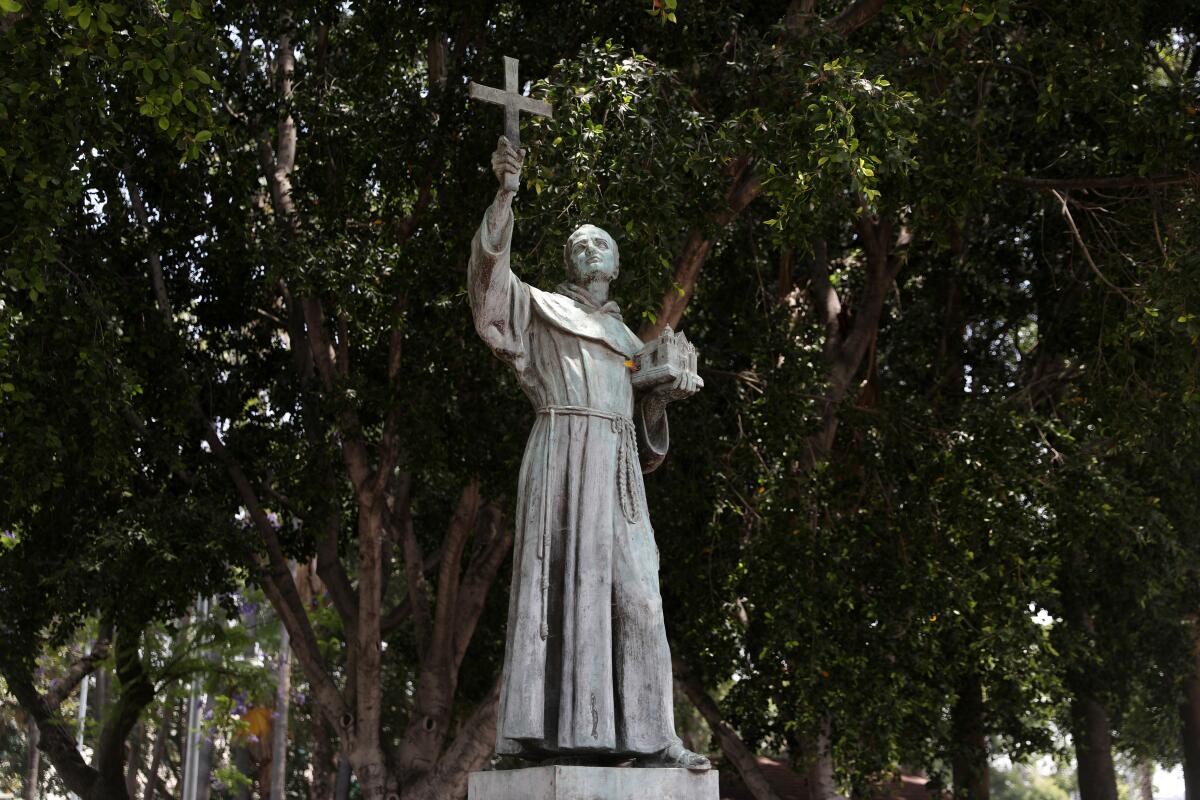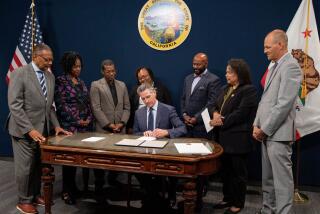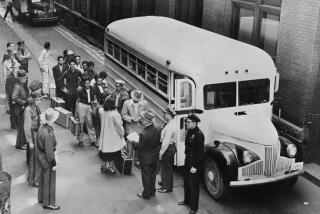California should not erase Junípero Serra. But it doesn’t need to honor him

- Share via
In an era of statue toppling and building denaming, what should be made of the legacy of Father Junípero Serra, saint and architect of California’s mission history, which was replete with forced labor of the state’s Native Americans, mistreatment and the loss or near-loss of their cultures? The question has been a perpetual struggle for Californians over the last few decades.
During the period of Spanish colonialization and missions, in which Serra was a founding leader, California lost 90% of its native population, much of that to diseases brought in by white men. It was ranchers and soldiers who quickly took and despoiled the land on which the Native Americans depended, which led them to flee to the missions, nine of which Serra had established. Once there, according to the National Catholic Reporter, they weren’t allowed to leave again, and were placed in forced labor. There were beatings and other abuses.
Serra sought to protect Native Americans from the worst mistreatment at the hands of the military, but oversaw a system that nonetheless brutalized many indigenous peoples, deprived them of basic rights and disrupted their way of life. Serra reportedly loved the Native Americans he encountered, but he also saw them as inferior — and in desperate need of conversion from their own spiritual beliefs that are believed to be older than Christianity.
He was upheld as the man who played a pivotal role in opening California to white expansionism, and excoriated for the same thing. Many Catholics revere him as a saint. Many others — including a substantial number of Catholics — are sorry he ever set foot in Alta California.
The state cannot erase Serra. Good or bad — and as with most historical figures, the truth is a mix — he is too key to its history. Like it or not, the missions transformed California’s people as much as the grazing of livestock brought by the Spanish changed the landscape.
But there is a difference between acknowledging aspects of history and honoring them. And so it was appropriate for Mayor Eric Garcetti on Monday — officially known in the city as Indigenous Peoples’ Day, but still Columbus Day to the federal government— to announce that Father Serra Park in downtown Los Angeles would be renamed. That’s the park where critics of Serra toppled his statue last year. The City Council will consider a formal apology to Native Americans for wrongs against them both under Spanish and Mexican rule, and during the era of the Gold Rush and westward expansion.
About three weeks after the Los Angeles statue was pulled down, the same thing happened to the Serra statue in Capitol Park in Sacramento. And in another fitting move, Gov. Gavin Newsom signed legislation in late September to replace that statue with a memorial to Native Americans.
Other statues of Serra have fallen or been moved by public entities. Which isn’t to say there’s no place for Serra anywhere in the state. He can be honored by the Roman Catholic Church’s own missions and in its churches. He already has received the ultimate honor of being named a saint, and from a Catholic perspective, that makes sense. He paved the way for Catholicism in the state. But the missions he oversaw included many deeply problematic aspects for the first Californians. It’s not for the state to honor the harm that took place under a religious regime.
The moves by Newsom and Garcetti are more than adjustments to the state’s unfortunate history of honoring the memory of Serra. They are a recognition of the terrible wrongs done to Native Americans in this state for the many years after Serra died.
It’s good to hear that L.A. will consult with local tribes about what to name Serra Park — Yangna, the Native American village located in what became the downtown area, might be one candidate. Though the history of Serra and the missions should not be erased, Californians know far too little about the people who lived on this land for thousands of years before a white person set foot on it. The people who own that history should be invited to play a major role in telling it.
More to Read
A cure for the common opinion
Get thought-provoking perspectives with our weekly newsletter.
You may occasionally receive promotional content from the Los Angeles Times.









